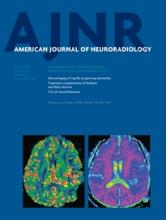Index by author
Gambaccini, M.
- LetterYou have accessComment on “Reproducibility of Cerebrospinal Venous Blood Flow and Vessel Anatomy with the Use of Phase Contrast–Vastly Undersampled Isotropic Projection Reconstruction and Contrast-Enhanced MRA”F. Sisini, A. Taibi, M. Gambaccini, E. Menegatti and P. ZamboniAmerican Journal of Neuroradiology March 2014, 35 (3) E3; DOI: https://doi.org/10.3174/ajnr.A3868
Gauvrit, J.-Y.
- EDITOR'S CHOICEExpedited PublicationOpen AccessWEB-DL Endovascular Treatment of Wide-Neck Bifurcation Aneurysms: Short- and Midterm Results in a European StudyB. Lubicz, J. Klisch, J.-Y. Gauvrit, I. Szikora, M. Leonardi, T. Liebig, N.P. Nuzzi, E. Boccardi, F.D. Paola, M. Holtmannspötter, W. Weber, E. Calgliari, V. Sychra, B. Mine and L. PierotAmerican Journal of Neuroradiology March 2014, 35 (3) 432-438; DOI: https://doi.org/10.3174/ajnr.A3869
Short- and midterm results of endovascular aneurysm treatment with the new WEB-DL device were assessed in 45 patients from 12 European centers. Of these, 42 aneurysms were unruptured and most were located either in the MCA bifurcation or the posterior circulation. Adequate occlusion was observed in 81% and 90% of aneurysms at 6 and 13 months, respectively. Results suggest that WEB endovascular treatment of wide-neck bifurcation aneurysms offers stable occlusion in a class of aneurysms that are historically unstable.
Geyik, S.
- NeurointerventionYou have accessEndovascular Treatment of Middle Cerebral Artery Aneurysms with Flow Modification with the Use of the Pipeline Embolization DeviceK. Yavuz, S. Geyik, I. Saatci and H.S. CekirgeAmerican Journal of Neuroradiology March 2014, 35 (3) 529-535; DOI: https://doi.org/10.3174/ajnr.A3692
Gonzalez, L.F.
- FELLOWS' JOURNAL CLUBNeurointerventionYou have accessCoiling of Large and Giant Aneurysms: Complications and Long-Term Results of 334 CasesN. Chalouhi, S. Tjoumakaris, L.F. Gonzalez, A.S. Dumont, R.M. Starke, D. Hasan, C. Wu, S. Singhal, L.A. Moukarzel, R. Rosenwasser and P. JabbourAmerican Journal of Neuroradiology March 2014, 35 (3) 546-552; DOI: https://doi.org/10.3174/ajnr.A3696
The long-term complications of coil treatment of giant intracranial aneurysms were assessed in 334 instances when treatment consisted of only coiling (225), stent-assisted coiling (88), parent vessel occlusion (14), or balloon-assisted coiling (7). The authors concluded that coiling of large and giant aneurysms has reasonable safety profiles with good clinical outcomes, but aneurysm reopening was common. Stent-assisted coiling had lower recurrence, retreatment, and new or recurrent hemorrhage rates with no additional morbidity compared with conventional coiling. Aneurysm size was a major determinant of recanalization, retreatment, new or recurrent hemorrhage, and poor outcome.
Guo, H.
- EDITOR'S CHOICEBrainOpen AccessEvaluation of Common Structural Brain Changes in Aging and Alzheimer Disease with the Use of an MRI-Based Brain Atrophy and Lesion Index: A Comparison Between T1WI and T2WI at 1.5T and 3TH. Guo, X. Song, R. Vandorpe, Y. Zhang, W. Chen, N. Zhang, M.H. Schmidt and K. Rockwood for the Alzheimer's Disease Neuroimaging InitiativeAmerican Journal of Neuroradiology March 2014, 35 (3) 504-512; DOI: https://doi.org/10.3174/ajnr.A3709
This study assesses the usefulness of a set of established structural findings in Alzheimer disease with various MRI sequences at 2 different field strengths in 127 subjects. Scores of atrophy and lesion burden were reliable across sequences and unit strength and were lowest in individuals with cognitive impairment, higher in those with Alzheimer disease, and also correlated with age, cognitive performance, and amyloid-β test. Although the results were slightly better at 3T, the authors concluded that even at 1.5T scores were reliable.
Guo, X.
- BrainYou have accessSemiautomated Volumetric Measurement on Postcontrast MR Imaging for Analysis of Recurrent and Residual Disease in Glioblastoma MultiformeD.S. Chow, J. Qi, X. Guo, V.Z. Miloushev, F.M. Iwamoto, J.N. Bruce, A.B. Lassman, L.H. Schwartz, A. Lignelli, B. Zhao and C.G. FilippiAmerican Journal of Neuroradiology March 2014, 35 (3) 498-503; DOI: https://doi.org/10.3174/ajnr.A3724
Gupta, A.
- FELLOWS' JOURNAL CLUBBrainOpen AccessAppropriate Use of CT Perfusion following Aneurysmal Subarachnoid Hemorrhage: A Bayesian Analysis ApproachR.P. Killeen, A. Gupta, H. Delaney, C.E. Johnson, A.J. Tsiouris, J. Comunale, M.E. Fink, H.S. Mangat, A.Z. Segal, A.I. Mushlin and P.C. SanelliAmerican Journal of Neuroradiology March 2014, 35 (3) 459-465; DOI: https://doi.org/10.3174/ajnr.A3767
These investigators evaluated the test characteristics of CTP in patients with SAH for detection of delayed cerebral ischemia. Ninety-seven patients were assessed with CTP for ischemia and with DSA for vasospasm. The authors concluded that positive CTP findings identified patients who should be carefully considered for induced hypertension, hypervolemia, and hemodilution and/or intra-arterial therapy while negative CTP findings are useful in guiding a no-treatment decision.
- Extracranial VascularYou have accessIntraplaque High-Intensity Signal on 3D Time-of-Flight MR Angiography Is Strongly Associated with Symptomatic Carotid Artery StenosisA. Gupta, H. Baradaran, H. Kamel, A. Mangla, A. Pandya, V. Fodera, A. Dunning and P.C. SanelliAmerican Journal of Neuroradiology March 2014, 35 (3) 557-561; DOI: https://doi.org/10.3174/ajnr.A3732








